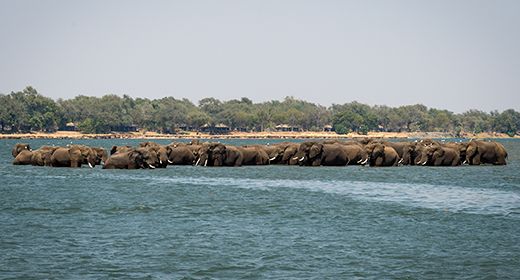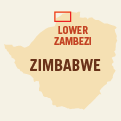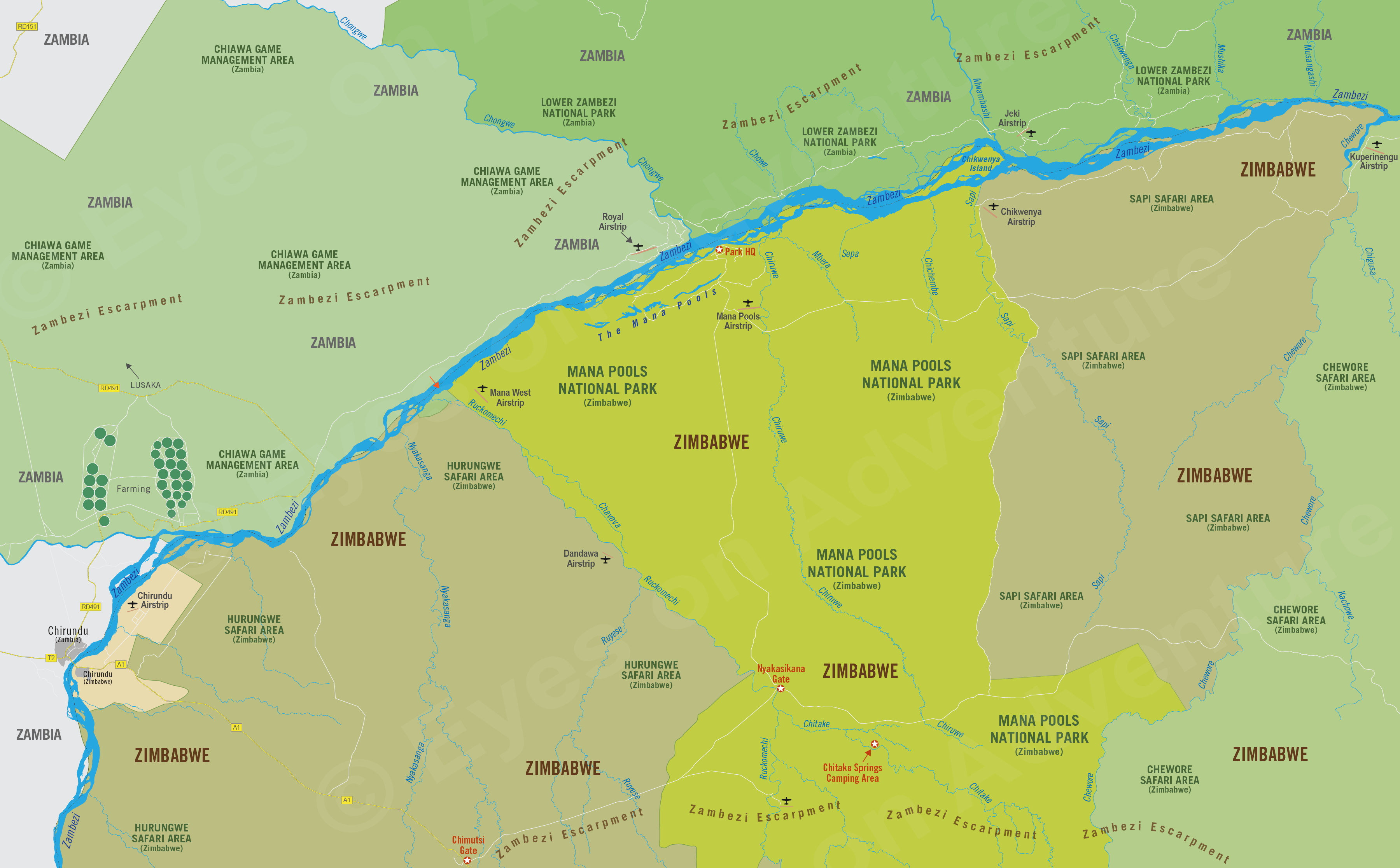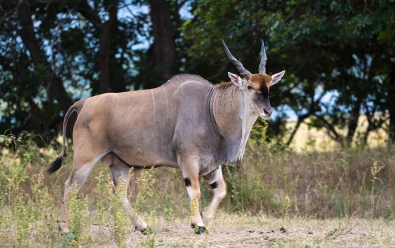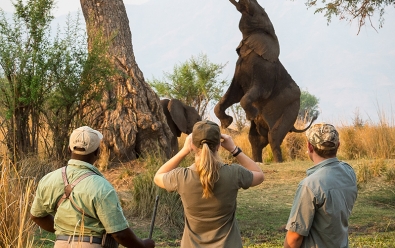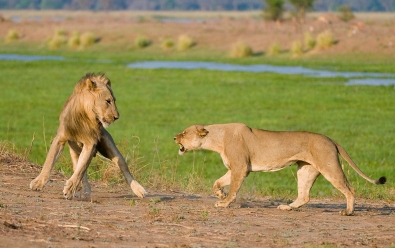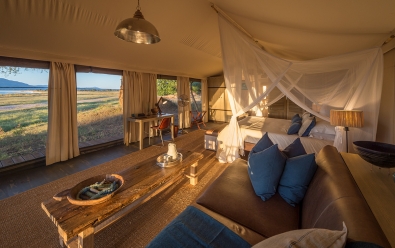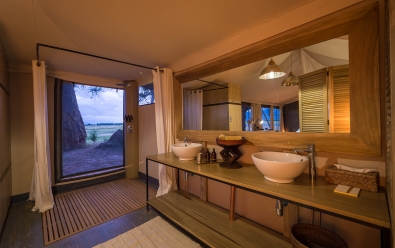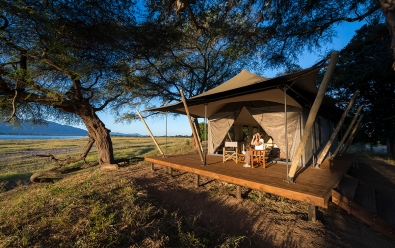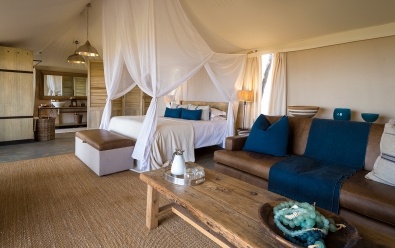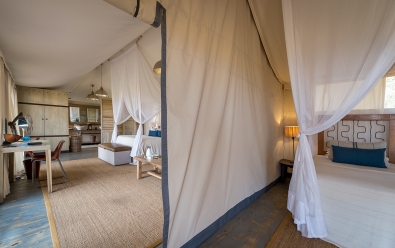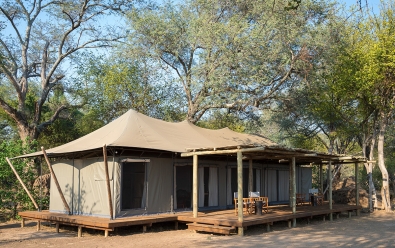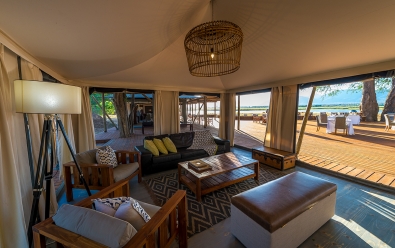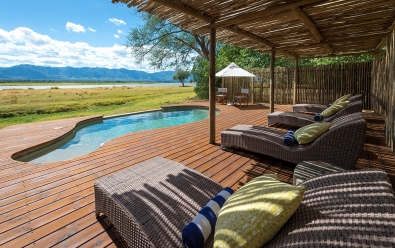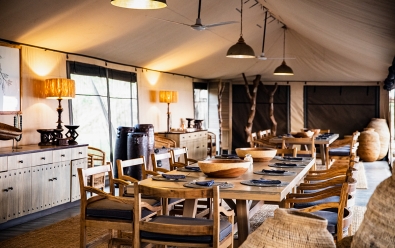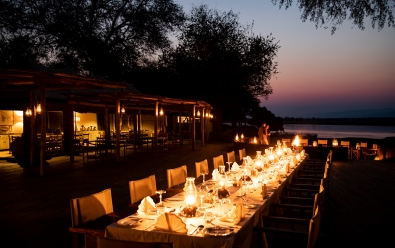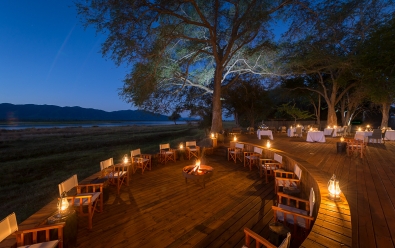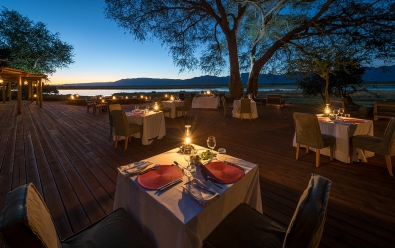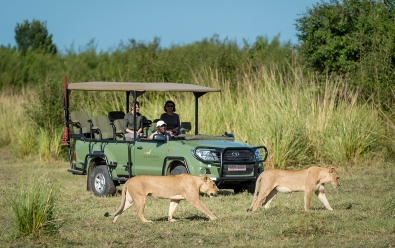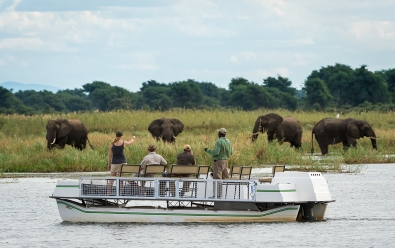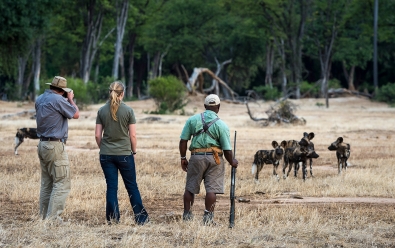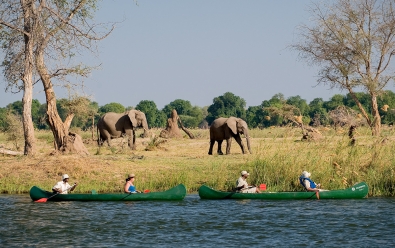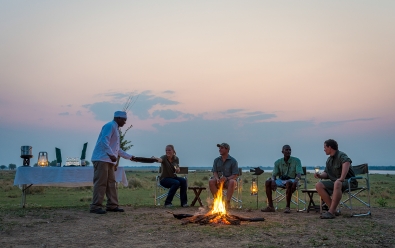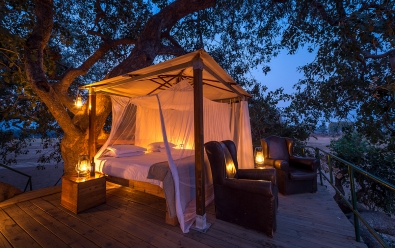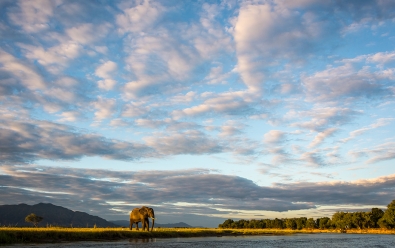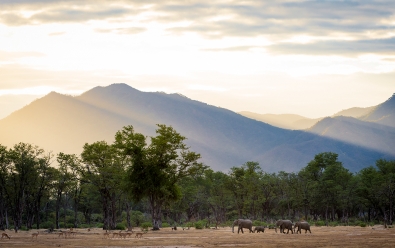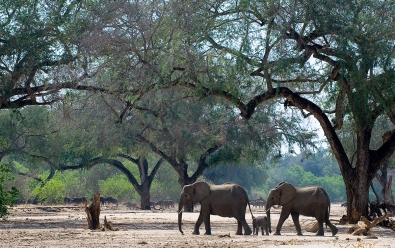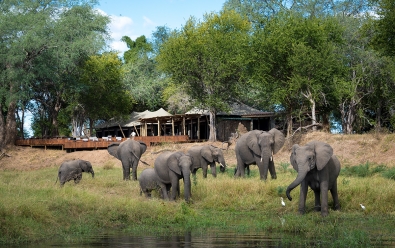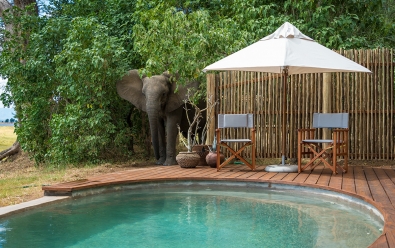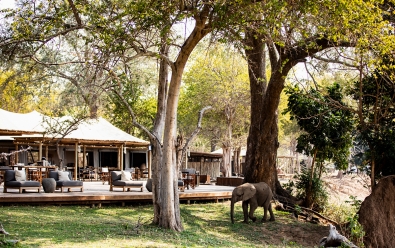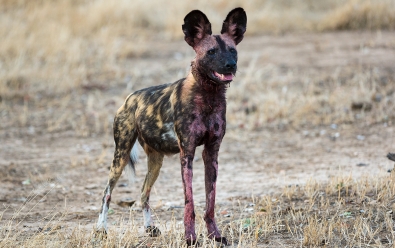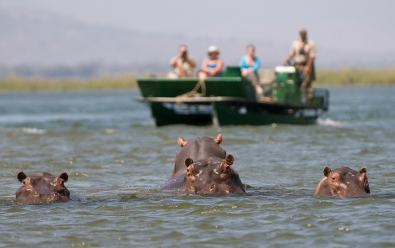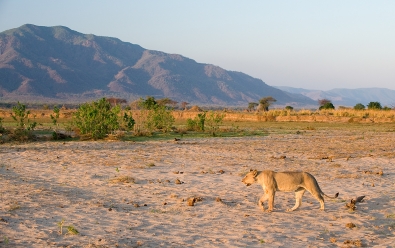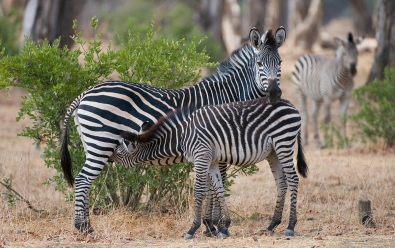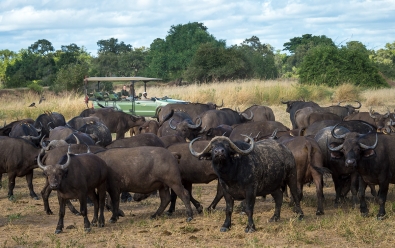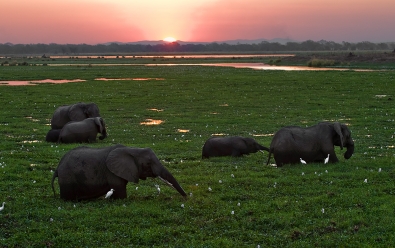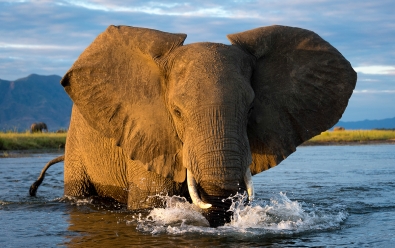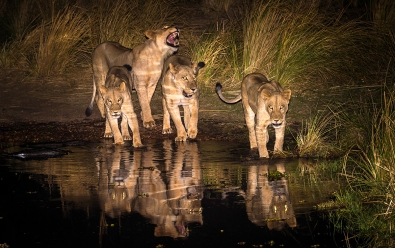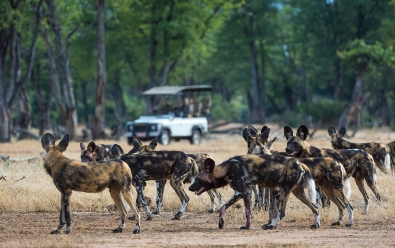Ruckomechi Camp
Highlights
- Seasonally spectacular wildlife viewing along the Zambezi River.
- Activities include safari drives, boating on the river, and guided walking.
- A true wilderness area that feels untouched with very low tourist numbers.
- Located in an exclusive concession adjoining Mana Pools National Park.
Location
- Ruckomechi Private Concession
- Lower Zambezi River
- Northern Zimbabwe
Ruckomechi Camp is located in a wildlife-rich private concession bordering Mana Pools National Park, a true wilderness in the Zambezi River Valley.
The camp is sited on the southern bank of the Zambezi River in a lush valley characterized by floodplains, open grassland, open woodland, forests of albida and mahogany trees, and the rugged Zambezi Escarpment which rises up from the valley floor further from the river. Ruckomechi's position on the river and directly bordering the national park mean that its guests enjoy total exclusivity in this incredible ecosystem.
Activities offered at Ruckomechi include game drives in open vehicles, boating and canoeing on the Zambezi River, catch-and-release fishing, and walking with an armed guide. The camp is only open during the dry/winter months, as during the rainy months, the roads in the area become too difficult to traverse.
Wildlife is abundant and varied at Ruckomechi, with large numbers of elephant, buffalo, impala, waterbuck, and zebra. Eland and greater kudu are also seen regularly. Predators include lion, leopard, cheetah, spotted hyena, jackal, and African wild dog. The Zambezi River is also home to a very large number of hippo and crocodile. Birding in the area is excellent.
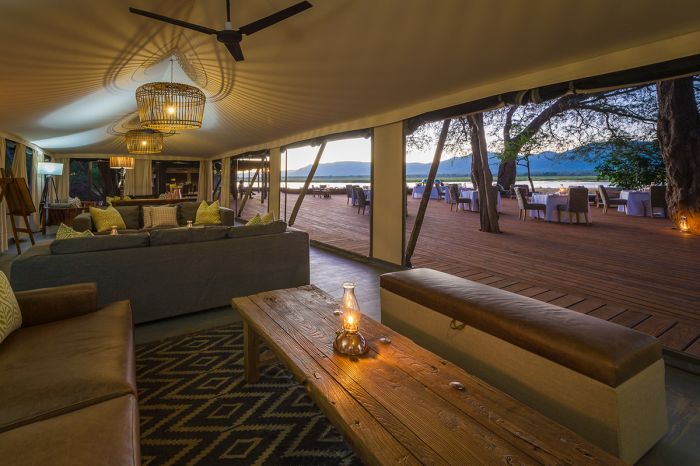
Main area lounge and view to outdoor deck.
Ruckomechi offers 10 spacious tented accommodations, 2 of which are double units and ideal for families. The tented rooms are constructed atop slightly elevated wooden decking with sandy footpaths connecting them to the camp's main area. The guest rooms have outdoor decks with seating and all tents look out over the floodplain and across the river all the way to the escarpment on the Zambian side.
The main camp area includes a dining, lounge, and bar area on elevated wood decks to maximize the views in front of camp. There is also a star-gazing and campfire deck, as well as a separate partially-shaded pool deck, all with excellent views of the Zambezi River.
Wilderness Safaris are one of Africa's leading safari operators and they strive to minimize energy consumption at all their camps. Ruckomechi Camp is powered by a hybrid system, which combines solar power and a diesel-powered generator. Water for the showers is heated by solar-powered geysers and solar panels at each tent charge the 12V lights in the tents at night. Strict eco-friendly environmental standards are maintained so that no harmful chemicals or waste is allowed to enter the pristine ecosystem of the Lower Zambezi.
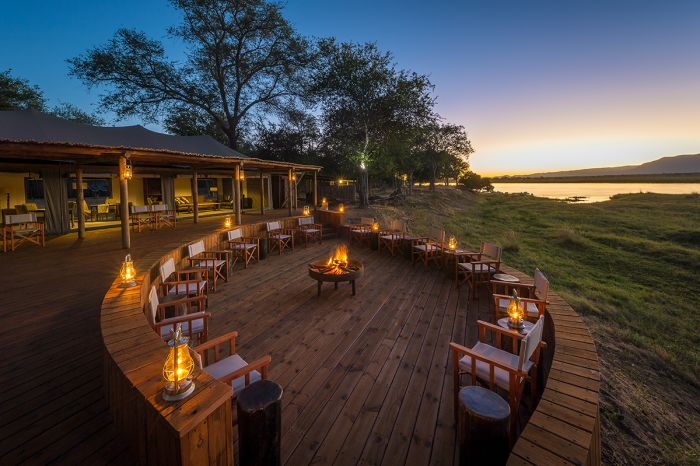
Campfire deck and view to the lounge and the river.
About The Lower Zambezi
Zimbabwe's Mana Pools National Park is located in the Lower Zambezi Valley, a remote protected area along the Zambezi River that covers land in both Zimbabwe (south of the river) and Zambia (north of the river). The Zambezi River forms the boundary between Zimbabwe and Zambia in this area. The Zambezi Valley is flanked on both sides by the rugged Zambezi Escarpment, which rises over 3 300 feet (1 000 meters).
The lifeblood of the entire Lower Zambezi Valley, including Mana Pools NP, is the Zambezi River, which originates hundreds of miles away in far northwest Zambia. This mighty river flows south through Zambia, over The Victoria Falls, east into Lake Kariba and into the Lower Zambezi Valley.
The Zimbabwean side of Lower Zambezi includes Mana Pools National Park and the adjoining Sapi and Chewore Safari Areas further east and was declared a UNESCO World Heritage Site in 1984. The Zambian side of the river is protected by Lower Zambezi National Park and the Chiawa Game Management Area.
The combined protected areas of the Lower Zambezi are one of Southern Africa's most diverse wildlife destinations and one its most outstanding wilderness areas.
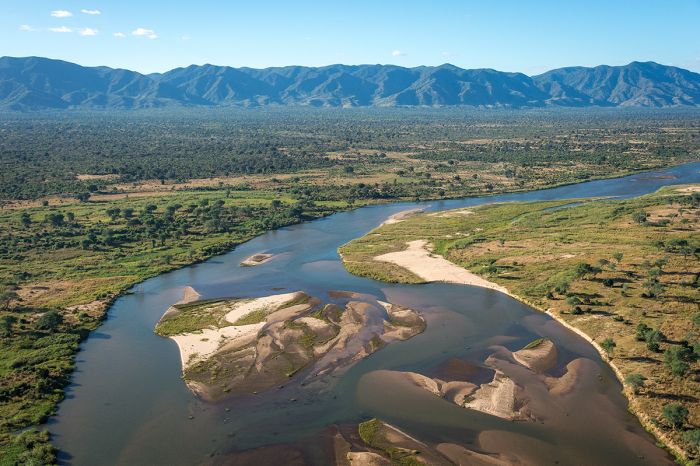
Aerial view of the Zambezi River, floodplains, and the escarpment on the Zambian side.
About Mana Pools
Mana Pools is part of an extensive, unfenced natural habitat that is home to diverse and abundant wildlife on the southern side of the Zambezi River. The combined protected area includes Mana Pools National Park (848 sq mi/2 196 sq km), Sapi Safari Area (456 sq mi/1 180 sq kms), and Chewore Safari Area (1 309 sq miles/3 390 sq kms) and stretches east to the Mozambique border.
The national park is named for four semi-permanent pools just south of the river that are remnants of a prior river course and are now a favored refuge for large numbers of hippo and crocodile. The word 'mana' means 'four' in the local Shona language.
Mana Pools is well known for its superb wildlife diversity, as well as its beautiful scenery. The park is one of the most remote in Southern Africa and one never need worry about many tourists, as the small number of safari camps means it can never be crowded. The area truly feels untouched by time.
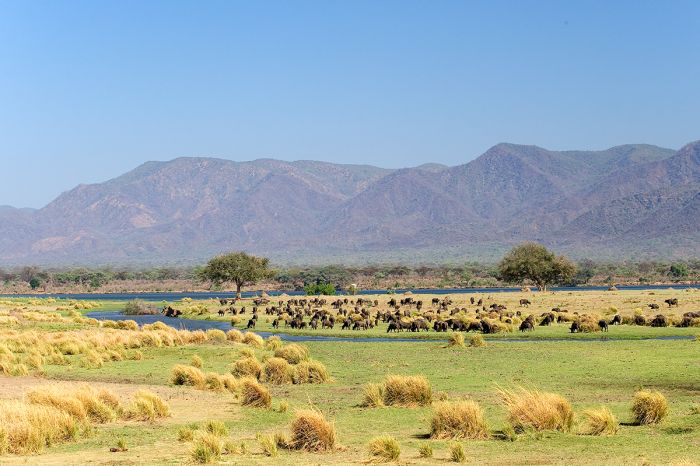
Buffalos grazing on the floodplain grasses along the Zambezi River.
Four of Africa's Big Five animals are found in Mana, including elephant, lion, leopard, and buffalo. Black rhino once existed here, but they are now gone.
Mana is perhaps most known for its elephants, especially the good number of extraordinary big bulls, which are very relaxed by nature and often wander through the safari camps, casually feeding while taking little notice of any humans. One popular sight which you may be lucky to see is one fo these big bull elephants standing on only its two rear legs to reach high into a tree for tasty seed pods.
Buffalo are seen in good numbers, either in breeding herds or small groups of old bulls. Like the elephants, buffalos freely cross the Zambezi River back and forth between Zimbabwe and Zambia, often stopping on one of the numerous river islands to graze.
Lions are not difficult to find, especially during the dry season when they remain near the river floodplains, which are teeming with wildlife during the winter months. Leopards are more elusive but are seen regularly. Spotted hyenas are here in good numbers, as are black-backed jackal. Cheetah are present, but only seen occasionally.
Mana is one of the best places in Africa to see African wild dogs, with several oft-seen packs traversing the area. These entertaining predators are seen regularly as they hunt the floodplains along the river in the early morning or near dusk.
Besides the abundant predators, Mana Pools is home to a large variety of herbivores, including impala, zebra, waterbuck, bushbuck, greater kudu, and warthog. The region is one of the best places in Southern Africa to see eland, the continent's largest antelope. Giraffe are not found in Mana Pools and there is no evidence that they ever existed here.
The Zambezi River itself is home to a huge number of hippo and crocodile and anyone canoeing or boating on the river is sure to see plenty of both species. Pods of hippo can be seen sunning along the river banks are more often just wallowing in the shallows along the banks.
Bird life is abundant in Mana Pools, with over 400 species recorded. Large colonies of beautiful carmine bee-eaters use the river banks for nesting holes and African skimmers use sand flats for their nesting.
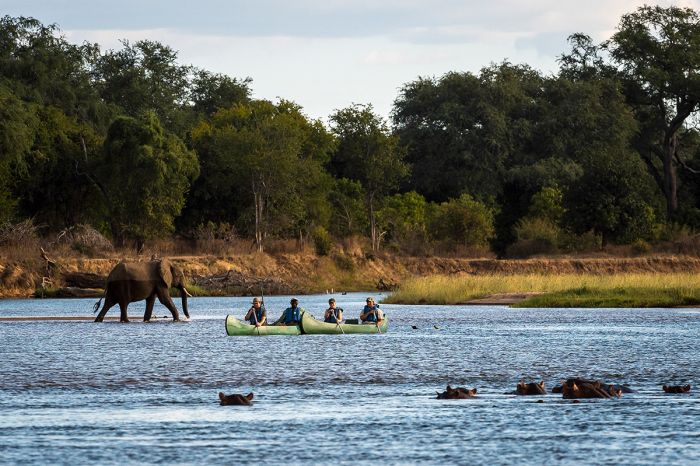
Canoeing on the Zambezi River.
ROOMS INCLUDES & EXCLUDES CHILDREN FACILITIES ACTIVITIES
Accommodation
10 guest accommodations in total comprising:
- 8 twin-bedded canvas tents, each with two three-quarter beds.
- 2 family units consisting of two bedrooms, each with two three-quarter beds. Bedrooms are separated by a drop-down canvas blind and each has its own en-suite facilities. Both bathrooms have an indoor shower, double-basin vanity, and separate toilet. There are separate entrances, but a shared outdoor deck with seating area.
Each luxury canvas-tented accommodation is constructed atop low-level wooden decking with views of the Zambezi River. En-suite facilities include an indoor shower, a double-basin vanity, and separate toilet. Each unit also has a small, private outdoor veranda with deck chairs.
The units are connected to the main camp area by sandy pathways on the ground.
Ruckomechi Camp may be booked in conjunction with its sister camp, Little Ruckomechi, for larger groups. Please note, it is approximately a 4-km (20-minute drive) between the two camps.
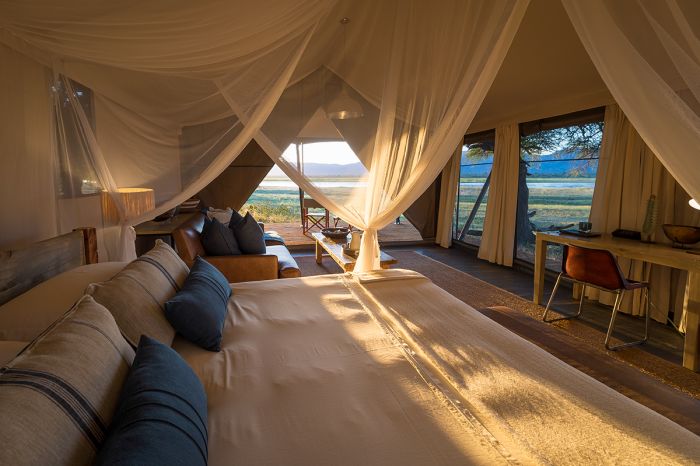
Guest tent interior and view.
Guest room amenities include easy chairs and an ottoman, a writing desk and chair, canvas blinds that roll up and down for all weather conditions, multi-plug charging facilities, a small veranda with deck chairs, and mosquito netting for the beds.
Other items and features in the guest units include:
- Luggage rack.
- Individual canvas bags with padlocks (keys remain with guests) are supplied for valuables, which are then stored in a central safe.
- Tea and coffee making facilities (hot water provided in the morning).
- Pedestal fan.
- In-tent Wi-Fi.
- Personal amenities, including bathrobes, liquid soap, shampoo and conditioner, body lotion, room spray, insect repellent, mosquito coil, shower caps, vanity kit with cotton-tip swabs, cotton wool pads, garment washing powder (for underwear), tissue dispenser, and umbrella.
Ruckomechi Camp can accommodate a maximum of 24 guests in total: 2 adults and 2 children in each of the 2 family rooms and 2 persons in each of the other 8 tented rooms.
Includes & Excludes
Includes:
- All meals and local beverages including wines, spirits and liqueurs, but excluding premium imported brands and Champagne.
- Twice-daily scheduled camp activities (accompanied by experienced guides).
- Laundry services are provided on a daily basis (weather permitting, items will be returned on the same day). Laundry is dried by the sun and on most days any laundry placed out in the morning will be returned by the evening.
- Wi-Fi access.
- Tourism levy and VAT.
Excludes:
- Premium imported beverages and Champagne.
- Any applicable wildlife fee, park fee, reserve fee, concession fee, other land-use fee.
Single Supplement
A single supplement will apply for any room booked by a single traveler; please ask us for pricing.
Children
Children aged 6 years and older are accommodated at Ruckomechi:
- For families traveling with children between 6 and 12 years, private activities must be booked and paid for.
- Children between 6 and 16 years must share with an adult/s in the same room.
- The minimum age for boating activities is 6 years.
- The minimum age for canoeing activities is 16 years.
- The minimum age for walking activities is 13 years.
Facilities
The camp main area and guest tents are built under a canopy of albida trees with views over the river to the Rift Valley Escarpment on the Zambian side.
- Lounge, dining, and bar areas are constructed atop raised wooden decks.
- Pool in the main area with partially shaded deck and loungers.
- Outdoor deck with sunken lounge and campfire deck overlooking the Zambezi River.
- One outdoor bath privately located on the banks of the Zambezi River, which is independent from all tents and thus available for use to all guests.
- Guest toilets in main area.
Activities
Activities included in the rate:
- Day and night game drives in 5x 7-seater open Toyota Hilux vehicles. During winter months, hot water bottles, blankets, and lined ponchos are provided on game drives.
- A pair of Olympus binoculars is available in each of the game drive vehicles for guests to share amongst themselves while game viewing and may be requested from the guides.
- Water-based activities in 2x 8-seater pontoon boats, 1x 4-seater speed boat, 5x 2-seater canoes, and 1x 9-seater (3x bench seating) Pelican boat.
- Fishing is possible on a catch and release basis from the bank or by boat.
- Birding.
- Guided nature walks.
- Sleep-outs in the Star-Bed treehouse at Parachute Pan (weather permitting); approximately 40-minutes drive from camp.
- Stargazing with a laser pointer.
- River cruises (usually a sunset cruise).
Optional activities at additional cost:
- Private activities are on offer (subject to vehicle availability which needs to be booked in advance). The private vehicle is shared with Little Ruckomechi.
Example of a typical day:
- Early morning wake-up call. Morning wake-up and activity times vary according to the seasons, activities on offer, and wildlife sightings.
- Light breakfast before departing on the morning activity.
- Return to camp for a meal and rest period.
- Meet for afternoon tea and snacks (savory and sweet choices) before departing on the activity.
- Return to camp - freshen up or meet for drinks, followed by dinner.
- Enjoy a nightcap or discussion around the fire before retiring.
Great Good Fair Poor
- Jan
- Feb
- Mar
- Apr
- May
- Jun
- Jul
- Aug
- Sep
- Oct
- Nov
- Dec
When To Visit
Like most of Southern Africa, the Mana Pools area has distinct seasonal variations that are primarily determined by local rains. Temperatures are mild to very warm all year.
The summer/rainy season begins around mid-November and continues into mid-April. During this time, much of the park and its game drive tracks become very difficult or even impassable and many of the safari camps are closed or have limited activities at this time.
The winter/dry season (from June through October) is the best time to visit Mana Pools.
Ruckomechi Camp is open from 01 April to 19 November.
WINTER / DRY SEASON
The dry season is the best time to visit the Lower Zambezi and Mana Pools National Park. The season runs from May thru October and during this time, there is almost no rain whatsoever. The wildlife viewing is at its best in winter, with herds of elephant, buffalo, and antelope congregating along the permanent waters in the Zambezi River. Rainwater pans and minor waterways inland from the Zambezi River dry up up as the season progresses and the animals are forced to remain close to the river.
Many of the safari camps in the area are only open during the dry season, but due to the very low density of accommodations here, the national park and areas bordering the park are never crowded and you may not see any other people other than those in your camp.
May is a lovely time to visit, with lush, green vegetation still covering the landscape. Late rains are possible, but most days are sunny and clear. Daytime temps average 73-77°F (23-25°C), with overnight lows averaging 49-51°F (9-11°C).
June and July are the chilliest months of the year and rain is extremely unlikely. The bush begins to lose its verdant color and by late July, has become dry. Daytime temps are warm, averaging 75-78°F (24-26°C), but the early mornings are chilly and morning game drives will require dressing in layers. Overnight temps drop to an average of 47-51°F (8-10°C). Wildlife viewing, particularly around and remaining water sources and along the Zambezi River, is very good.
August and September are the very best months to visit the Mana Pools area. Game viewing is outstanding, especially along the Zambezi River, as it is basically the only water source until the rains come in November/December. The landscape is now very dry and the only good grazing is on the floodplains along the Zambezi River, where herds of elephants, zebra, buffalo, waterbuck, and other species congregate to feed. Temperatures are rising, with daytime highs reaching 86-91°F (30-33°C) and nights and early mornings only falling to a pleasant 55-63°F (13-17°C).
October is by far the warmest and driest month of the year. Wildlife viewing continues to be outstanding, with the river floodplains teeming with animals. The best time for safaris is early in the day before the sun gets too high and again later in the afternoon. Midday temperatures average 93-98°F (34-37°C) and the overnight temps only drop to 66-69°F (19-21°C). Due to the very warm days, safari drives are shorter, with animals seeking shade from mid-morning until late-afternoon.
Summer / Rain Season
The first rains typically fall anytime from late-October to mid-November, bringing relief to the parched landscape and the wildlife. The early part of the season is still a very nice time to visit the Mana Pools region, with fresh grasses and new vegetation starting to emerge. Some herbivores, particularly impala, time their birthing season to coincide with the arrival of the summer rains.
November rains usually only occur every other day or so on average and are typically afternoon showers only lasting 1-2 hours. Temperatures are still quite warm, with daytimes averaging 88-92°F (31-33°C). Afternoon showers cool things down if they occur. Overnight temps drop to around 64-67°F (18-19°). Some safari camps may close for the season during November.
December through February receive the most rain, with most days receiving at least some precipitation, but all-day rains are unusual. Game-drive roads can become difficult or unusable at this time. The smaller waterways, which are typically dry for most of the year, are now flowing and wildlife disperses away from the Zambezi River towards the Zambezi Escarpment to feed on the abundance of fresh vegetation. Wildlife viewing becomes somewhat more challenging, with animals now spread out away from the river.
March is approaching the end of the rainy season, with showers decreasing in frequency and volume. Temperatures are roughly the same from December through March, averaging 82-88°F (28-31°C) during the day and 64-70°F (18-21°C) overnight.
April is the transition month between the rainy and dry season, with only sporadic showers and gradually decreasing temperatures. The bush is verdant and thick after the months of rainy days and some safari tracks may still be difficult for driving. Daytime temps average 84-86°F (29-30°C) and overnight/early morning temps are comfortable, averaging 51-54°F (10-12°C).




